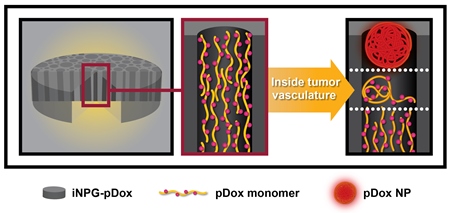Breast Cancer
Breast Cancer Breakthrough: An Injectable Nanoparticle Generator Enhances Delivery of Cancer Therapeutics



Posted May 17, 2016
Mauro Ferrari, Ph.D., Houston Methodist Research Institute
 Incurable metastatic dissemination of tumor cells from the primary tumor is the leading cause of cancer-associated deaths. Numerous biological barriers prevent adequate drug delivery and accumulation within tumors, thwarting effective tumor eradication, especially in metastatic lesions. As a result, many scientists have focused their research on creating drug-carriers with the ability to bypass these biological barriers and allow for proper drug delivery to primary and metastatic lesions. One such drug carrier is the nanoparticle, which is a small-diameter particle that can be externally modified for tumor homing and packaged with chemotherapeutic agents to mediate tumor killing. Unfortunately, multifunctional nanoparticles have had limited clinical utility and none have been adopted into clinical practice. To improve the utility of nanoparticles, Dr. Mauro Ferrari, supported by an FY11 Breast Cancer Research Program (BCRP) Innovator Expansion Award, explored the use of an injectable nanoparticle generator (iNPG) created by his laboratory that was loaded with polymeric Doxorubicin (pDox) to treat metastatic lung tumors in mice.
Incurable metastatic dissemination of tumor cells from the primary tumor is the leading cause of cancer-associated deaths. Numerous biological barriers prevent adequate drug delivery and accumulation within tumors, thwarting effective tumor eradication, especially in metastatic lesions. As a result, many scientists have focused their research on creating drug-carriers with the ability to bypass these biological barriers and allow for proper drug delivery to primary and metastatic lesions. One such drug carrier is the nanoparticle, which is a small-diameter particle that can be externally modified for tumor homing and packaged with chemotherapeutic agents to mediate tumor killing. Unfortunately, multifunctional nanoparticles have had limited clinical utility and none have been adopted into clinical practice. To improve the utility of nanoparticles, Dr. Mauro Ferrari, supported by an FY11 Breast Cancer Research Program (BCRP) Innovator Expansion Award, explored the use of an injectable nanoparticle generator (iNPG) created by his laboratory that was loaded with polymeric Doxorubicin (pDox) to treat metastatic lung tumors in mice.
In a landmark paper published this year (2016) in Nature Biotechnology, Dr. Ferrari was able to selectively inhibit metastatic lung tumor progression in a mouse model of human breast cancer and effectively cure a subset of treated mice. The designed iNPG consisted of a nanoporous silicon particle packaged with pDox (iNPG-pDox) that had the ability to self-assemble into nanoparticles within the tumor microenvironment and be released intratumorally. Once the pDox nanoparticle self-assembled, pDox was shown to be internalized by tumor cells specifically, while sparing all surrounding tissues. Following internalization, the nanoparticle disassembled into free Dox, resulting in rapid tumor cell death. Using multidrug-resistant MDA-BM-231 breast cancer cell lines and their non-resistant counterparts in vivo, Dr. Ferrari showed that iNPG-pDox was able to reverse resistance to doxorubicin, leading to a reduction in lung metastatic tumor load, whereas the individual nanoparticle components or current therapeutic formulations used as controls had no effect on lung tumor burden. Moreover, mice treated with iNPG-pDox experienced 80% survival after 20 weeks, when all mice in the control groups had succumbed to disease, and 50% of the pDox-treated mice achieved long-term survival. These results were reproduced in a second mouse model. Mice treated with iNPG-pDox had little to no traces of metastatic tumors four weeks after treatment, with about 40% of mice surviving over 180 days. In humans, this is equivalent to about 24 years of long-term survival following diagnosis with metastatic disease.
Cardiac toxicity resultant from chemotherapeutic agent treatment for metastatic disease limits a patient's ability to tolerate treatment and eventually leads to cessation of therapy. Dr. Ferrari and his team, using the iNPG, have provided a strategy to overcome this toxicity issue. They were able to show that the iNPG-pDox particles were rapidly eliminated from circulation and preferentially homed to the liver (frequent site of breast cancer metastasis) and tumor-bearing lungs, where high levels were maintained up to seven days. Intriguingly, the iNPG-pDox did not lead to any cardiac toxicity even one day after treatment when levels were detectable in the heart. When the biodistribution of iNPG-pDox was examined over the course of a week, it was found that no iNPG-pDox could be detected in the heart one week after treatment, whereas the individual components or current therapeutic formulation controls that were injected alone were detectable one week after treatment and did lead to cardiac toxicity. Furthermore, during dose toxicity experiments, mice treated with four times the recommended therapeutic dose of iNPG-pDox showed no adverse side effects, whereas the mice treated with Doxil (doxorubicin formulation encapsulated in liposomes for intravenous use in the clinic) developed severe cardiomyopathy.
For the first time, Dr. Ferrari has shown the ability to improve long-term survival of mice with lung metastases using iNPG-pDox and effectively cure approximately 40% of those animals. Using the injectable nanoparticle generator packaged with doxorubicin, Dr. Ferrari effectively inhibited lung metastatic progression and eliminated toxicity to cardiac tissue. Houston Methodist Hospital has developed Good Manufacturing Practices (GMP) for the iNPG-pDox and plans to fast-track the research to obtain FDA-approval. Safety and efficacy studies in humans are planned to commence in 2017.

Publications:
Xu R, Zhang G, Mai J, Deng X, Segura-Ibarra V, Wu S, Shen J, Liu H, Hu Z, Chen L, Huang Y, Koay E, Huang Y, Liu J, Ensor JE, Blanco E, Liu X, Ferrari M, Shen H. 2016. An injectable nanoparticle generator enhances delivery of cancer therapeutics. Nature Biotechnology 34(4):414-418. doi:10.1038/nbt.3506
Links:
Public and Technical Abstracts: Multistage Vector-Enabled Breast Oncology
Last updated Thursday, December 5, 2024














